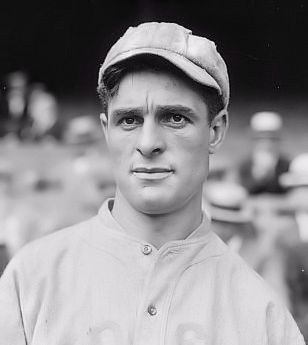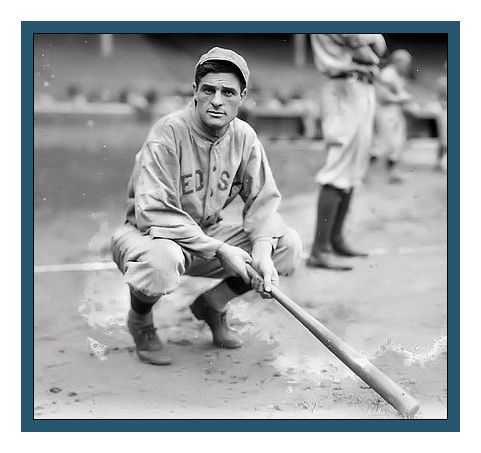|
“FENWAY'S BEST PLAYERS”  |
|||
An intelligent player whom both teammates and opponents respected, 29-year-old first baseman Dick Hoblitzell opened the 1918 season as the Red Sox' captain and cleanup hitter, but an early-season slump and his June induction into the Army Dental Corps marked an inglorious end to an otherwise distinguished 11-year career in the major leagues. Though he spent the more productive early part of his career with the Cincinnati Reds, "Hobby" looked back most fondly on his time with three World Champion teams in Boston, and in later years he kept in touch with Red Sox teammates Larry Gardner, Harry Hooper, Herb Pennock, and Tris Speaker. The middle of three sons, Richard Carleton Hoblitzell was born on October 26, 1888. His mother, the former Laura Alcock, was of English descent, while his father, Henry Hoblitzell, whose ancestors hailed from the oft-disputed Alsace-Lorraine region, was part German, Swiss, and French. When Dick was eight years old his mother died and the family moved a short distance downriver to Parkersburg, West Virginia. Dick captained the Parkersburg High School football team during his freshman and sophomore years, and it was around that time that he gained his first professional baseball experience. As Dick told the story, Henry Hoblitzell had remarried a woman from France and Dick was not getting along with his stepmother, so he accepted an invitation to join a barnstorming Bloomer Girls team to get away from her. Henry ended up having to retrieve him somewhere in Pennsylvania. For his last two years of high school, Dick attended prep school at Marietta Academy on the Ohio side of the Ohio River. Dick starred at halfback for the 1905-06 Marietta College football teams and in the fall of 1907 enrolled at the Western University of Pennsylvania, which became known as the University of Pittsburg the following year. He played end for the famous WUP football team. Earlier that year Dick had played professional baseball with Clarksburg, West Virginia, of the Pennsylvania and West Virginia League, assuming the alias of "Hollister" to protect his amateur status. After playing shortstop for two weeks, the 6-footer was pressed into duty at the initial sack when Clarksburg's regular first baseman got injured. Though Dick had never played the position before, it became the one that he manned for 1,284 contests in the majors. When the 1908 school year ended, Dick jumped his contract with Clarksburg to join Reading, Pennsylvania, of the outlaw Union League. When that league folded after only six weeks, he accepted an offer from Newark of the Eastern League. Dick remained in Newark for two weeks, awaiting settlement of his case. On June 30 he was informed that Clarksburg had sold him to Wheeling of the Central League. Returning to his native state, Hoblitzell appeared in 53 games and attracted attention by batting .357. The Reds purchased Hoblitzell from Clarksburg on August 21. Making his debut with the Reds on September 5, 1908, Dick took over at first base for player-manager John Ganzel and batted .254 over the last 32 games of the season. In 1909 he appeared in 142 games and batted a career-best .308, third highest in the National League behind only Honus Wagner and teammate Mike Mitchell. Over the five-year period 1909-13, the left-handed-hitting slugger batted in the heart of the Cincinnati order and was the top run producer in the Reds' strong offensive attack. During the first half of 1914, the 25-year-old Hoblitzell mysteriously lost his ability to hit, slumping all the way to .210 after 78 games. He cleared waivers, a trade with the New York Yankees fell through, and on July 16 the Boston Red Sox claimed him off the waiver wire for a mere $1,500. Hobby rebounded during the second half of 1914 to hit .319 in 69 games, plugging a hole in the Boston lineup and turning the Sox into pennant contenders. Assigned to share a room on the road with Babe Ruth, the steady and gentlemanly Hoblitzell remained Boston's regular first baseman throughout the start of the 1918 season, usually batting third or cleanup in the batting order and performing well. In successive years, he hit .283, .259, and .257 in 1915 through 1917. He also performed admirably in the World Series of 1915 and 1916, playing in every game. He hit .313 in 1915 while six walks boosted his on-base percentage to .435 in the 1916 Series. Declared eligible for the military draft, Dick took and passed an examination for the U.S. Army Dental Corps in March 1918. After reporting late to spring training, he opened the regular season with only one hit in his first 25 at-bats and was eventually benched with an injured finger on May 6. His replacement at first base that day was none other than his old roommate Ruth, making his first major league appearance at a position other than pitcher. Hoblitzell received his commission as a first lieutenant on June 6 and left the Red Sox three days later, his teammates presenting him with a gold wristwatch as a going-away present. The Red Sox went on to win another World Series, awarding Hobby a partial share of $300 from the proceeds. Dick never played another game in the majors, retiring with a lifetime batting average of .278. While stationed in El Paso, Texas, Dick contracted influenza and nearly died during the 1918 pandemic. After his discharge from the Army in 1920, Hoblitzell played for and managed the Charlotte Hornets of the Sally League for five seasons, leading the team to a pennant in 1923. Dick gave up baseball to work full time in the real estate business with his partner, Lee Kinney, though he eventually returned to the Hornets dugout in 1929-30 for the highest salary ever paid to that point to a Sally League manager. In addition to raising cattle and growing produce, Dick hosted a sports radio show on WPAR, wrote a column on sports and other topics for the Parkersburg News, and umpired youth baseball. He was active in Republican politics, serving as county treasurer and being elected sheriff. Dick also served as superintendent of the Sunday school at the Episcopal church. The former ballplayer kept himself in excellent shape, his weight never much exceeding his playing weight of 172 pounds, and he managed to avoid illness until he contracted the colon cancer that killed him on November 14, 1962.
|
|||

